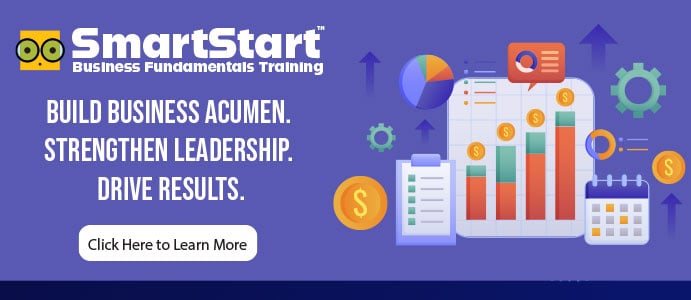For years, transactional business acumen training lived in the corner of the Learning Management System, a stand-alone course, often sandwiched between time management and communication skills. However, today, the most progressive organizations are taking a radically different approach to embracing the skills needed to understand and set strategy, and then measure the execution of that strategy through financial reports and performance metrics.
System, a stand-alone course, often sandwiched between time management and communication skills. However, today, the most progressive organizations are taking a radically different approach to embracing the skills needed to understand and set strategy, and then measure the execution of that strategy through financial reports and performance metrics.
They’re thinking across the organization, treating business acumen not as an isolated skill, but as a critical organizational competency that connects all functions and drives the creation of value for customers, employees, and shareholders.
From Check-the-Box to Enterprise Capability
In forward-thinking companies, business acumen isn’t just another line item in the learning catalog. It’s a capability that grows with the learner and the business.
Rather than offering one generic course for everyone, these organizations are designing step-based learning journeys that build a shared language of business. It starts simple and becomes more strategic over time:
- New hires and early-career employees learn how a company makes money, what revenue is, how gross margin is calculated, and why profit isn’t just “what’s left.”
- New and mid-level managers explore the balance sheet and cash flow, understanding how operational decisions ripple across functions.
- High-potential leaders dive deeper into EBITDA, return on working capital, and the financial levers that drive growth and efficiency.
- Sales professionals apply business acumen externally, learning how their customers make money, and how to position value in financial terms.
- Executives sharpen their ability to lead strategy execution, aligning people, processes, and investments to create sustainable performance.
Each level is a building block, the foundation for the next. And together, they form a continuous learning journey that develops not just more capable individuals, but a more aligned, commercially intelligent enterprise.
A Simulation-Centric Learning Journey
What’s making this evolution possible isn’t just good design, it’s simulation-centric learning.
At Advantexe, we’re seeing more organizations use multi-dimensional business simulations that tell a common business story with varying levels of complexity. Early-career learners might manage a simplified version of a company, making basic pricing or cost decisions, while senior leaders work within the same storyline but face far more complex, cross-functional trade-offs and strategy challenges.
This creates a shared narrative of learning, one where everyone speaks the same business language, but with the right level of challenge for their role.
And because simulations immerse learners in real decisions and outcomes, they transform abstract financial concepts into practical, memorable experiences. Instead of hearing about how cash flow works, learners see it in real time as their decisions play out.
The Holy Grail of Learning: Expanding Access Through AI and Delivery Innovation
Scaling this learning across the enterprise requires more than good content; it demands flexibility. That’s why organizations are blending asynchronous experiences for large audiences with high-touch sessions for senior leaders:
- Individual contributors have access to self-paced simulations powered by AI tools, including the AI Board of Directors and AI Coach, which provide personalized feedback and performance insights.
- Managers and high-potentials engage in hybrid learning journeys that combine asynchronous rounds with virtual debriefs and group coaching.
- Executives participate in facilitated master classes that pair advanced simulations with AI-enabled role plays to practice strategy communication and business dialogue skills.
The result is a scalable, cohesive learning architecture where everyone, from new hires to senior leaders, learns to think like a businessperson and act like an owner.
Why It Matters
When business acumen is embedded across levels and functions, something powerful happens:
- Cross-functional alignment improves because people understand how their decisions affect others.
- Strategic conversations become more focused, data-driven, and value-oriented.
- Employees at all levels begin to connect their daily work to enterprise success, increasing engagement and accountability.
- Execution improves because strategy isn’t just understood, it’s lived.
In short, business acumen serves as the bridge that connects learning to performance.
The Future of Business Acumen: Thinking Across the Organization
The next wave of business acumen isn’t about teaching finance terms. It’s about building a culture of holistic thinking, one where employees understand the cause-and-effect of their actions and how value is created across the entire business system.
Progressive organizations are realizing that to compete in complex, fast-changing markets, they need people who can think across silos, understand trade-offs, and make decisions that drive sustainable success.
And that starts with one simple idea: Business acumen isn’t a one-time course. It’s an organizational culture.




